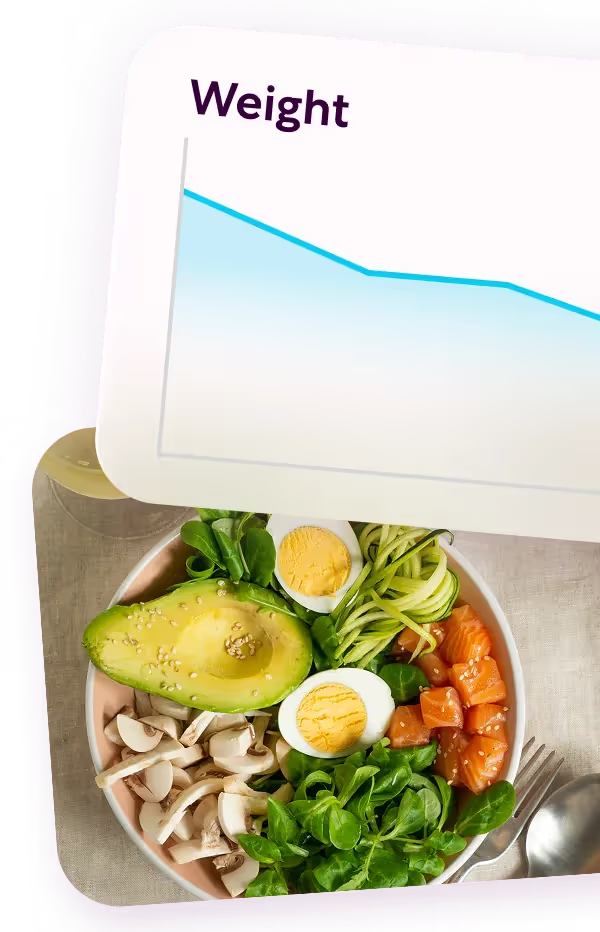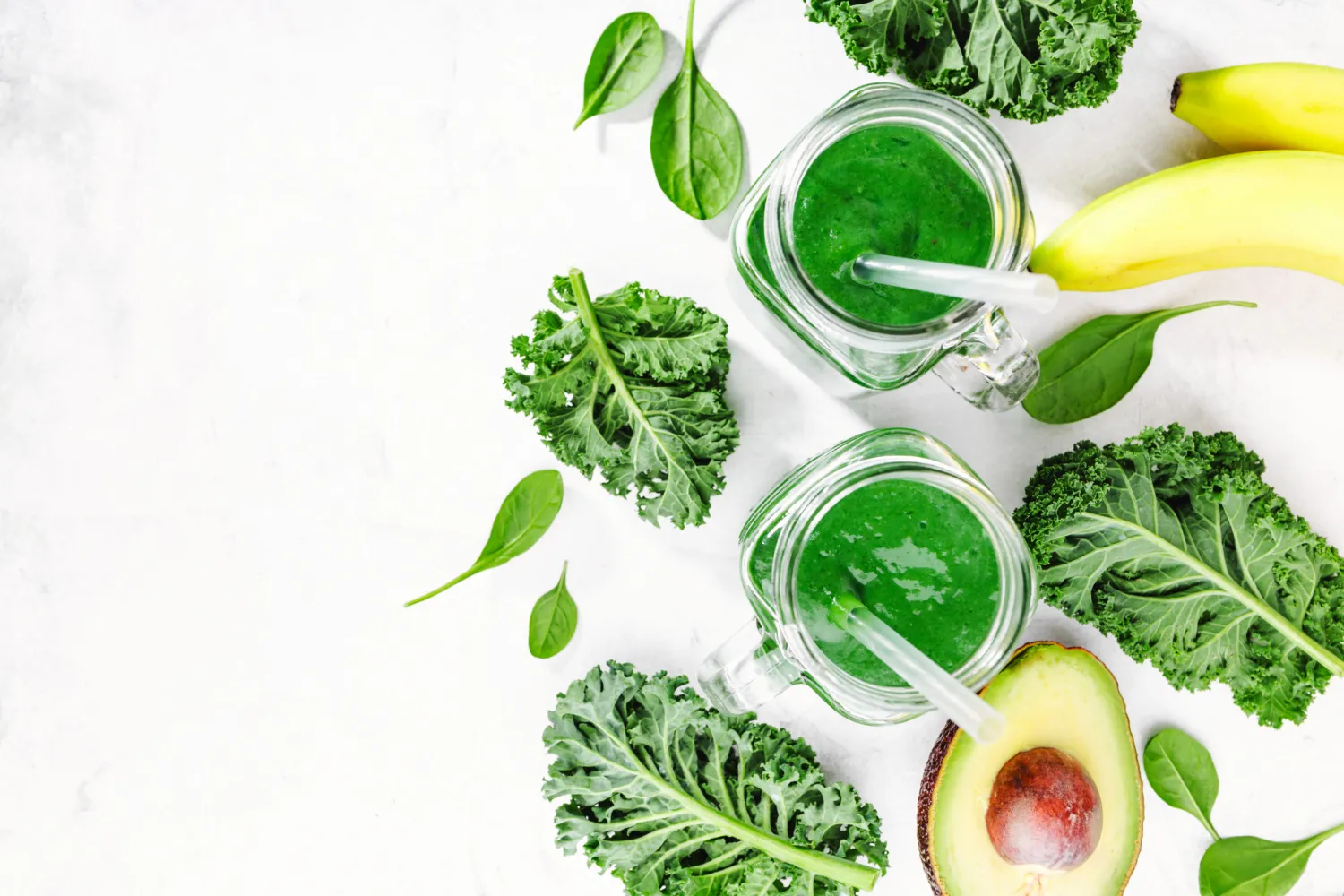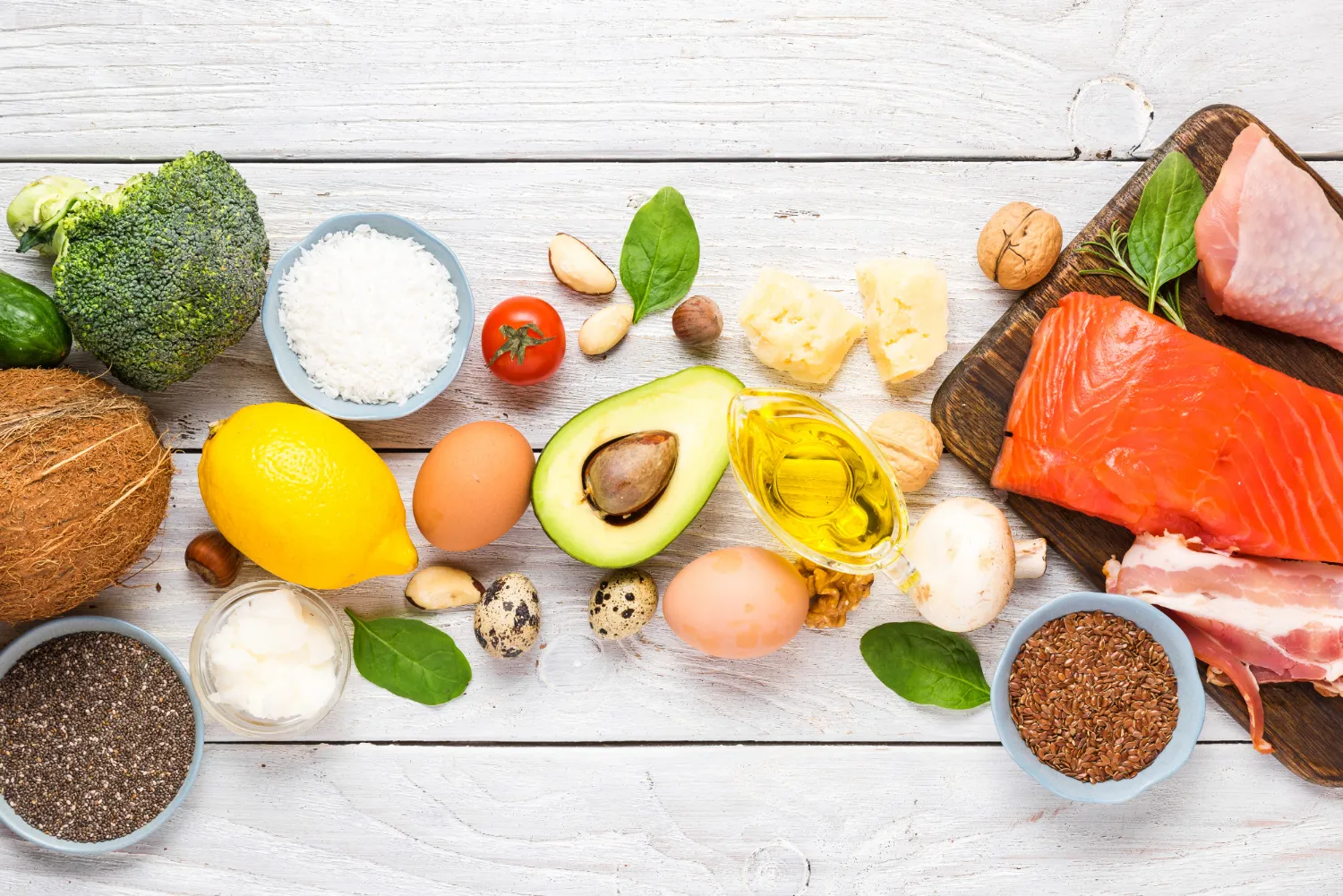Keto that finally moves the scale again.
Get your plan
Keto that finally moves the scale again.
Get your plan
Traditional Indian cuisine celebrates carbohydrates through staples like rice, roti, and sweets, making the transition to keto seem impossible at first glance. But it’s not. India’s culinary heritage is rich enough that you’ll find keto-friendly ingredients that can make this dietary shift feel less foreign and more manageable.
This guide explores how Indian women can embrace ketosis while honoring cultural food traditions, addressing everything from pantry staples to meal preparation.
Understanding the Keto Diet for Indian Women

The ketogenic diet works by drastically reducing carbohydrate intake and replacing it with fat. This reduction puts your body into ketosis, a metabolic state where you burn fat for energy instead of glucose. This is the biggest pain point for Indian women interested in the ketogenic diet. Their traditional eating patterns usually center around rice, wheat, and legumes.
However, keto is particularly beneficial for Indians. Research shows South Asian populations often experience insulin resistance at lower body weights than other ethnicities. This phenomenon, sometimes called "thin-fat syndrome," means even normal-weight Indian women might benefit from the blood sugar-stabilizing effects of ketosis.
We’ve also got more good news for you. Indian cuisine already celebrates many fat-rich foods like ghee, coconut, nuts, and seeds that serve as perfect keto staples. This means achieving 70-75% calories from fat, 20-25% from protein, and only 5-10% from carbohydrates is doable with some guidance.
Best Keto-Friendly Indian Foods

Healthy Fats (Ghee, Coconut, Nuts, Avocados)
This traditional fat offers medium-chain triglycerides that support ketosis while delivering a rich, nutty flavor to dishes. Many Ayurvedic traditions already celebrate ghee for its digestive benefits, making it culturally familiar to Indian women transitioning to keto.
Coconut-based products provide excellent fat sources. From coconut oil for cooking to coconut milk for curries and coconut flour for low-carb baking, these versatile ingredients can help your dishes maintain an authentic and familiar flavor while keeping the carbohydrate count low.
Nuts like almonds, walnuts, and seeds such as pumpkin and sunflower serve as perfect keto snacks or meal additions. These foods have long been part of Indian culinary traditions and offer protein alongside healthy fats. Butter fruit (avocado), though not traditionally Indian, is a popular alternative and provides monounsaturated fats for better heart health.
Protein Sources for Vegetarian and Non-Vegetarian Diets
Paneer (Indian cottage cheese) shines as perhaps the most versatile keto-friendly protein, containing virtually zero carbs while delivering substantial protein. You can transform paneer into bhurji (scramble) or tikka (grilled cubes) or stuff it into low-carb vegetables for a quick and easy meal.
You can also introduce these varieties and Greek yogurt to your diet for added protein while maintaining fat.
If you’re open to including eggs in your diet, these provide complete protein with near-zero carbohydrates. Dishes like masala omelets or egg curry work great on keto as you can prepare them without using starch. Plant protein sources like tofu offer alternatives, though they contain slightly higher carb counts than animal proteins.
Chicken and fish prepared in traditional Indian styles—minus the starchy or sugary components—are also keto staples. Tandoori preparations, kebabs, and curries made with fatty cuts work exceptionally well. Fatty fish like salmon and mackerel deliver omega-3 fatty acids alongside protein, supporting both ketosis and heart health.
You might also want to consider adding organ meats. Nutrient-dense options like the liver, heart, and kidney are full of vitamins and minerals often lacking in muscle meats.
Low-Carb Vegetables and Spices for Flavor
Focusing on above-ground vegetables drastically reduces carb intake while maintaining nutritional density. Spinach (palak), fenugreek leaves (methi), cabbage (patta gobhi), and cauliflower (phool gobhi) serve as excellent keto-friendly vegetable bases.
The Indian spice cabinet offers unparalleled flavor variety that doesn’t contain much carbohydrates, if at all. Turmeric, cumin, coriander, cardamom, cloves, cinnamon, and countless other spices transform simple ingredients into complex flavor profiles. These spices also provide health benefits beyond their taste contributions—many offer anti-inflammatory properties that complement the keto diet's effects.
Many traditional Indian recipes also center on ingredients like aromatics such as ginger, garlic, and green chilies, making the transition to keto preparations straightforward when you replace your typical carb-heavy meals. Vegetables like bitter gourd (karela) and eggplant (baingan) are good examples of this while providing nutritional profiles typically not found in Western keto diets.
How to Replace High-Carb Indian Staples
Keto Alternatives for Roti, Rice, and Dal
The greatest challenge for Indian women transitioning to keto involves replacing beloved staples like roti and rice, but it isn’t impossible. Cauliflower rice is a surprisingly effective rice substitute for this purpose, capable of absorbing flavors from curries and gravies while providing only a fraction of the carbs. Grated, quickly sautéed cauliflower mimics rice texture.
For roti alternatives, consider almond flour or coconut flour flatbreads. While they won't perfectly replicate the texture of wheat rotis, they satisfy the practical need for something to scoop up curries. Many Indian women find success with "fat head" dough—a mixture of melted cheese, almond flour, and eggs—which creates pliable, low-carb flatbreads that withstand the scooping motion required for Indian-style eating.
Dal presents particular challenges because legumes contain significant carbohydrates. Some keto followers create facsimile dal textures using pureed pumpkin or zucchini with traditional dal spicing. But you can enjoy the occasional small portions of moong dal, as they don’t contain as much carbohydrates.
Low-Carb Substitutes for Indian Sweets
Traditional mithai relies heavily on sugar, milk solids, and flour—ingredients that quickly exceed daily carb limits. Fortunately, creative substitutions allow for keto-friendly versions of beloved treats without sacrificing cultural connections.
You can replace Khoya with a mixture of ground nuts, ghee, and a touch of heavy cream. Natural sweeteners like stevia, erythritol, or monk fruit provide sweetness without glucose spikes. Coconut-based desserts adapt particularly well to keto modifications, as coconut already features prominently in many regional Indian sweets.
Almond flour offers similar binding properties to Besan (chickpea flour) with far fewer carbohydrates. You can make a simple keto-friendly dessert by combining ground almonds with ghee, cardamom, and a low-carb sweetener, mimicking the texture and flavor profiles of traditional ladoos. For special occasions, small portions of berries provide natural sweetness with minimal carb impact compared to traditional sugar syrups.
Finally, full-fat paneer or cream cheese mixed with cardamom, saffron, and keto-friendly sweeteners creates satisfying alternatives to rasmalai or similar milk-based sweets.
How to Modify Traditional Recipes to Stay in Ketosis
Many Indian curry and sabzi preparations can maintain their character even when you replace carb-heavy ingredient staples. The first step involves eliminating obvious carbohydrate sources like potatoes or corn from vegetable preparations. Next, reconsider thickening agents. Traditional recipes often use besan (chickpea flour), cornflour, or mashed potatoes to create thickness. Xanthan gum, ground flaxseed, or pureed low-carb vegetables can achieve similar textures without the carbohydrate spike. You can also use more tomato paste rather than adding fresh tomatoes for a more concentrated flavor while keeping the carbohydrate count to a minimum.
Onions present a particular challenge. Rather than eliminating them entirely, many keto cooks use smaller amounts of raw onion for flavor impact, then discard the pieces before serving. Alternatively, onion-flavored ghee (prepared by infusing ghee with onions, then straining) provides the characteristic flavor without the carb content.
For meat preparations like kebabs, skip bread-based binders and use cheese, eggs, or crushed pork rinds instead.
Keto Meal Plan for Indian Women

7-Day Sample Vegetarian Keto Meal Plan
Breakfast Options:
- Paneer bhurji scrambled with spinach and cooked in ghee, accompanied by avocado
- Greek yogurt topped with crushed nuts, chia seeds, and a few berries
- Coconut flour pancakes with sugar-free maple syrup and butter
- Keto upma made with grated cauliflower instead of semolina
- Cheese and vegetable omelette cooked in abundant ghee
- Almond flour dosa with coconut chutney
- Bulletproof coffee with a side of keto-friendly nutty granola
Lunch Options:
- Cauliflower rice pulao made with mixed nuts and paneer cubes
- Palak paneer prepared with extra ghee and minimal onions
- Stuffed bell peppers filled with spiced paneer and nuts
- Cabbage thoran with coconut and curry leaves
- Cucumber raita using full-fat yogurt as a side dish
- Simple garden salads dressed with olive oil and lemon
- Paneer tikka with mint chutney
Dinner Ideas:
- Vegetable curry made with coconut milk instead of tomato gravy
- Mixed vegetable stir-fry with abundant ghee or coconut oil
- Grilled paneer with spiced vegetables and yogurt sauce
- Keto-friendly baingan bharta with extra olive oil
- Cauliflower and broccoli curry with almond cream
- Spinach and mushroom curry with added cheese
- Chaach (buttermilk) as an occasional evening drink
7-Day Sample Non-Vegetarian Keto Meal Plan
Breakfast Options:
- Masala omelette with spinach and cheese, cooked in ghee
- Boiled eggs with avocado slices and a side of nuts
- Bulletproof coffee or tea blended with ghee or coconut oil
- Egg bhurji with bell peppers and cheese
- Keto-friendly chicken keema with cauliflower poha
- Salmon squares with cream cheese and herbs
- Egg muffins with vegetables and spices, batch-prepared beforehand
Lunch Ideas:
- Butter chicken without added sugar, served with cauliflower rice
- Tandoori fish or chicken with mint-yogurt chutney
- Seekh kebabs with side salad dressed in olive oil
- Chicken curry made with coconut cream instead of regular cream
- Fish moilee prepared with extra coconut oil
- Mutton curry with spinach and minimal onions
- Sautéed leafy greens with lemon and extra virgin olive oil as sides
Dinner Options:
- Egg curry prepared with coconut milk rather than tomatoes
- Grilled fish with spicy cilantro chutney and vegetable sides
- Chicken 65 without breading, using almond flour if needed
- Meat stir-fries with low-carb vegetables like broccoli and peppers
- Bone broth seasoned with Indian spices for light dinner options
- Tawa chicken with minimal spices and added ghee
- Prawn curry with coconut milk and curry leaves
Recap: How to Succeed on Keto as an Indian Woman

Key Takeaways for a Sustainable Keto Lifestyle
Studies show that intermittent fasting pairs naturally with keto, which also aligns with cultural traditions around periodic fasting. Starting with a 16:8 approach—eating within an 8-hour window and fasting for 16 hours—often amplifies the effects of ketosis and the ketogenic diet.
However, what makes sticking to the ketogenic lifestyle particularly difficult are social settings. Family meals, festivals, and other gatherings often involve feasting on carbohydrate-rich foods. A good workaround is to prepare keto-friendly dishes ahead of time or only eat the protein and vegetable portions of shared meals. You can also practice selective fasting during special occasions, focusing on the social aspect instead.
This is why mental preparation is incredibly important. Your cultural attachment to traditional foods can make this transition much more difficult. A helpful method is to reframe your perspective and see the diet as a health tool rather than a way to deprive yourself. This can motivate you to push through when it becomes too difficult to resist.
Research shows that keeping a journal of improvements in energy, sleep quality, or medical markers can help reinforce your commitment when faced with temptation.
Best Indian Keto Foods to Include
Believe it or not, your kitchen is already full of keto-friendly options. Paneer stands out as perhaps the most versatile ingredient. This fresh cheese provides substantial protein with minimal carbs while absorbing flavors from various spice combinations. You can also make paneer at home, allowing you even more control over its fat content and freshness.
Coconut products deserve special attention in keto meal planning. Beyond coconut oil, coconut cream adds richness to curries without carbohydrates, while coconut flour works for the occasional baking. You might already use these ingredients regularly, so there’s no adjustment period.
Cruciferous vegetables like cauliflower, cabbage, and broccoli form the backbone of many Indian keto meals. These vegetables contain adequate fiber while keeping net carbs low. Leafy greens such as spinach, fenugreek, and mustard greens provide mineral variety alongside flavor. Traditional preparations like sarson ka saag or palak dishes adapt perfectly to keto when prepared with abundant ghee.
Don’t underestimate your spice cabinet as well. Garam masala, curry powders, and whole spices like cardamom, cinnamon, and cloves transform simple ingredients into satisfying meals. Research shows that many of these spices also offer health benefits that complement ketosis.
Tips for Staying Consistent with Keto Long-Term
Again. Social situations present the most challenge. Eating beforehand, focusing on protein portions, or simply planning on the occasional carbohydrate allowances around these important events can help you enjoy the company without feeling guilty.
Organizing your kitchen to support your diet also works. Dedicating time to preparing staples like cauliflower rice, keto rotis, and meat portions beforehand can help simplify meal preparations, allowing you to prepare dishes that usually take more than 30 minutes in half the time, if not less. Having grab-and-go options like nuts, cheese, or boiled eggs available can prevent impulsive snacking.
Tracking non-scale victories can help provide motivation during plateaus or challenging periods. Also, sharing your knowledge and joining online communities specifically for Indian keto practitioners works wonders for emotional support. You can even partner with friends or family members for accountability.
Ultimately, the ketogenic approach works best when you adopt it to yourself. You can turn it into a sustainable lifestyle if you take the time to experiment and eventually discover the right balance between following traditional practices and trying new eating patterns.
Keto that finally moves the scale again.
Get your plan
Sources
- Gujral, Unjali P., et al. "Type 2 Diabetes in South Asians: Similarities and Differences with White Caucasian and Other Populations." Annals of the New York Academy of Sciences, vol. 1281, no. 1, 2013, p. 51, https://doi.org/10.1111/j.1749-6632.2012.06838.x.
- Dyńka, Damian, et al. "Keto Menu–Effect of Ketogenic Menu and Intermittent Fasting on the Biochemical Markers and Body Composition in a Physically Active Man—A Controlled Case Study." Foods, vol. 12, no. 17, 2023, p. 3219, https://doi.org/10.3390/foods12173219.
- Khoury, Shireen R., et al. "Exercise As Medicine." Vascular Medicine, 2019, https://doi.org/10.1177/1358863X19850316.
- Khan, Amjad, et al. "Herbal Spices As Food and Medicine: Microscopic Authentication of Commercial Herbal Spices." Plants, vol. 13, no. 8, 2024, p. 1067, https://doi.org/10.3390/plants13081067. Accessed 19 Mar. 2025.
FAQs
Can Indian food be keto-friendly?
Yes, Indian food can be keto-friendly by replacing high-carb items like rice and roti with low-carb options such as cauliflower rice, paneer, and coconut-based dishes.
What are the best keto foods for Indian women?
The best keto foods for Indian women include paneer, eggs, leafy greens, coconut oil, ghee, and low-carb vegetables like cauliflower and zucchini.
Can Indian vegetarians do a keto diet?
Yes, Indian vegetarians can follow keto by eating paneer, tofu, nuts, seeds, and full-fat dairy while avoiding grains, legumes, and sugar.
Is keto safe for Indian women with PCOS or thyroid?
Yes, a keto diet may help manage PCOS and thyroid symptoms by reducing insulin resistance and supporting hormonal balance, but medical advice is recommended.
What does a 7-day Indian keto meal plan include?
A 7-day Indian keto meal plan includes meals like masala omelets, palak paneer, butter chicken, and cauliflower rice—low in carbs and rich in healthy fats.






